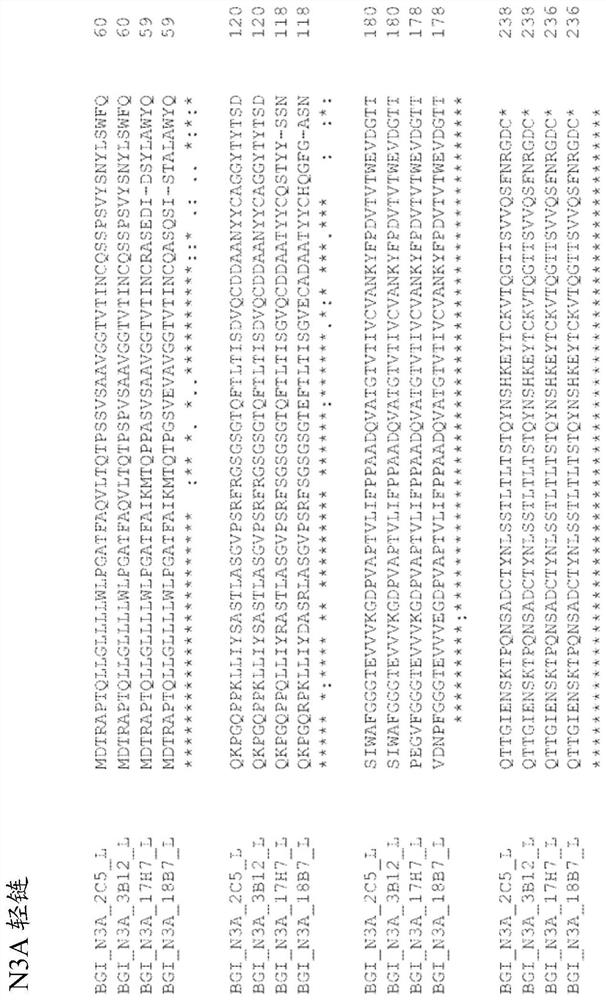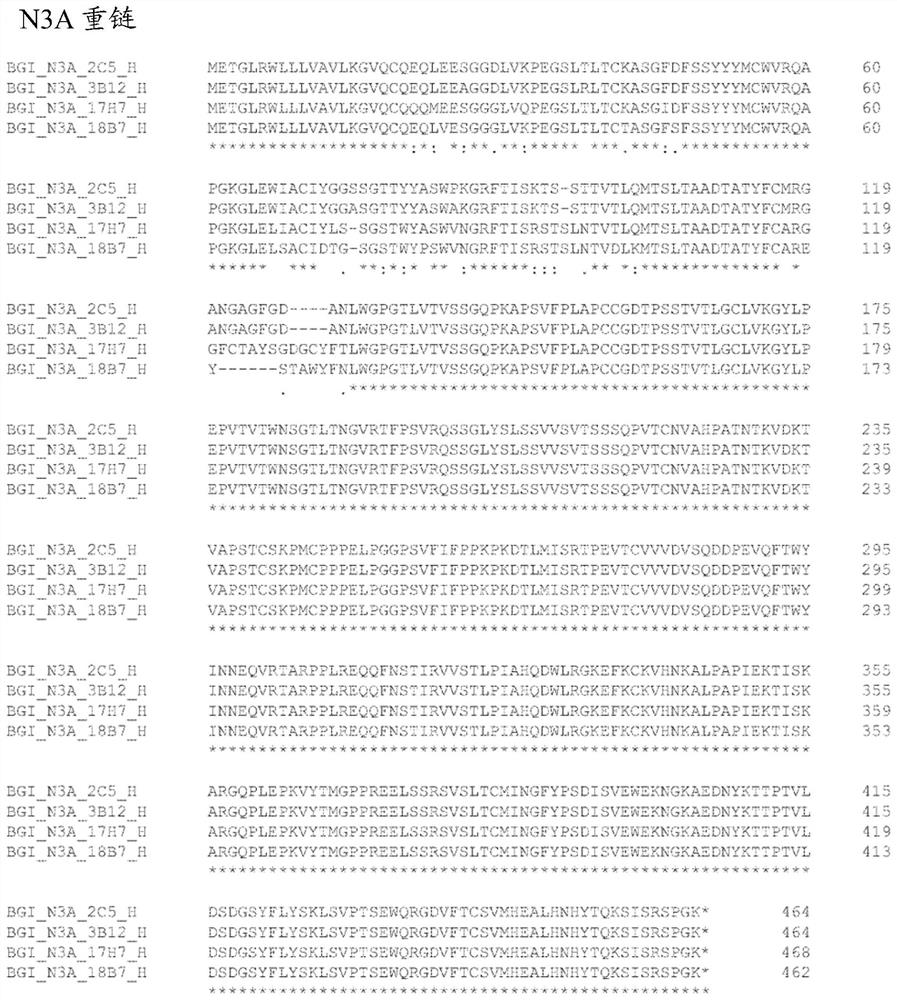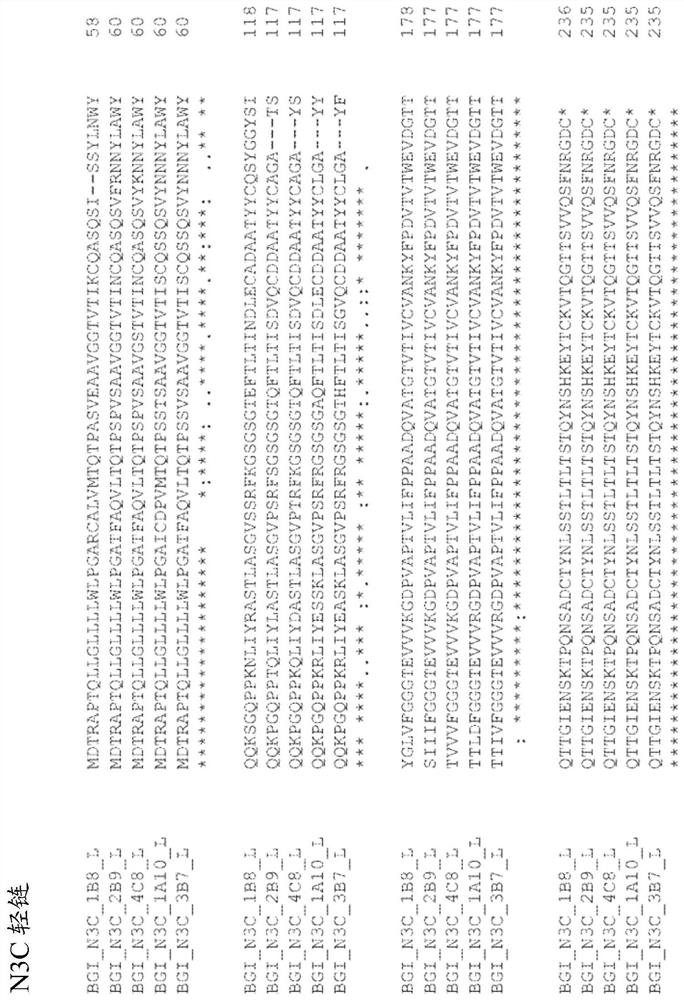Massively parallel sequencing using unlabeled nucleotides
An unlabeled, deoxyribonucleotide technology, applied in the direction of microbial determination/inspection, biochemical equipment and methods, can solve the problems of signal reduction and low incorporation efficiency
- Summary
- Abstract
- Description
- Claims
- Application Information
AI Technical Summary
Problems solved by technology
Method used
Image
Examples
Embodiment 1
[0450] Example 1: Rabbit anti-NLRT monoclonal antibody (mAb) and sequence
[0451] Generates 3'-azidomethyl-dA(N3A), 3'-azidomethyl-dC(N3C), 3'-azidomethyl-dG(N3G) or 3'-azide for KLH conjugation Rabbit monoclonal antibody to methyl-dT (N3T) (Yurogen Biosystems, Worcester, MA). Briefly, 8 rabbits were immunized with four different KLH-conjugated NLRTs, two rabbits for each of the four molecules. Bleeding analysis by ELISA was performed using each NLRT. On day 63 after immunization, rabbits were sacrificed and peripheral blood mononuclear cells (PBMC) or splenocytes were isolated. Rabbits were selected for cell sorting and culture of antibody-secreting B cells. Co-culture supernatants were screened using NLRT. Five or ten different anti-NLRT antibody clones (depending on target) were prepared for each of the four NLRTs, resulting in >30 mAb preparations.
[0452] Cloning of rabbit IgG genes from specific B cells identified by antigen screening. Obtain the heavy and ligh...
Embodiment 2
[0455] Example 2: Detection using a dN-azidomethyl-specific rabbit monoclonal antibody and a labeled goat anti-rabbit secondary antibody Measurement of NLRT incorporated in DNB arrays
[0456] Rabbit monoclonal antibodies N3A, N3T, N3G and N3C were used in this experiment. DNB arrays containing E. coli genomic DNA inserts were sensitized and primers extended using BG9 DNA polymerase (BGI, Shenzhen, China). Thirty antibody preparations were individually applied to separate lanes on the DNB array at 3 μg / mL or 25% culture supernatant as indicated and incubated at 35°C for 5 min (30 independent incubations). At the end of the incubation, unbound primary antibody was removed by washing the array at 35°C with antibody buffer (AbB) (Tris buffered saline pH 7.4 + 0.1% BSA and 0.05% Tween-20). The array was then incubated with Cy3-labeled goat anti-rabbit secondary antibody (Fab fragment) obtained from Jackson Immune Research (West Grove, PA, USA) at 35°C for 5 minutes. The arra...
Embodiment 3
[0462] Example 3: Sequencing by synthesis using labeled anti-NLRT monoclonal antibodies
[0463] E. coli genomic DNA libraries were prepared as previously described and arrayed on a BGISEQ-500 flow cell. Primers were added and sequence-by-synthesis was performed by primer extension using one target unlabeled nucleotide 3'-azidomethyl reversible terminator (dATP, dCTP, dGTP, dTTP) and three conventionally labeled reversible terminators in the ratio were: A-AF532 25% labeled, C-IF700 40% labeled, G-Cy5 35% labeled and T-ROX 35% labeled (in one experiment, two of the RTs (RT-A and RT -C) was routinely labeled, and two of the RTs (RT-G and RT-T) were detected by labeled monoclonal antibodies). The total concentration of 3′-blocked dNTPs was 1 μM for each nucleotide and incorporated using BG9 DNA at 55 °C and each cycle lasted 1 min. After incorporation and washing to remove unincorporated nucleotides, the array was incubated with a mixture of four directly labeled anti-3'-azid...
PUM
 Login to View More
Login to View More Abstract
Description
Claims
Application Information
 Login to View More
Login to View More - R&D
- Intellectual Property
- Life Sciences
- Materials
- Tech Scout
- Unparalleled Data Quality
- Higher Quality Content
- 60% Fewer Hallucinations
Browse by: Latest US Patents, China's latest patents, Technical Efficacy Thesaurus, Application Domain, Technology Topic, Popular Technical Reports.
© 2025 PatSnap. All rights reserved.Legal|Privacy policy|Modern Slavery Act Transparency Statement|Sitemap|About US| Contact US: help@patsnap.com



